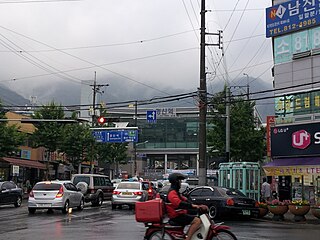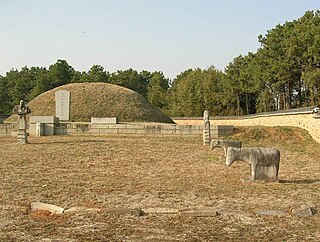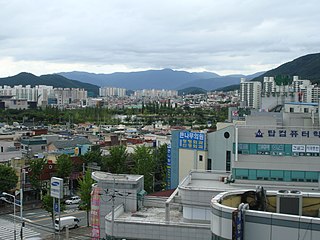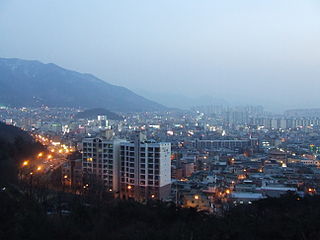
Gyeongsan is a satellite city in North Gyeongsang Province, South Korea. Its western border abuts the metropolitan city of Daegu, and much of Gyeongsan lies within the Daegu metropolitan area.

Sangju is a city in North Gyeongsang Province, central South Korea. Although Sangju is rather rural, it is very old and was once a key city. Along with Gyeongju, it gives rise to half of the name of the Gyeongsang provinces. Sangju is nicknamed Sam Baek, or "Three Whites", referring to three prominent agricultural products rice, silkworm cocoons, and dried persimmons from the area.

Gimhae is a city in South Gyeongsang Province, South Korea, situated near the Nakdong River.

On February 18, 2003, an arsonist set fire to a Daegu Metro subway train as it arrived at Jungangno station in central Daegu, South Korea. The resulting blaze, which spread when a second train stopped at the same station, killed 192 people and injured another 151. It remains the deadliest loss of life in a single deliberate incident in South Korean peacetime history, surpassing the 1982 shooting rampage committed by Woo Bum-kon.

Buk District is a district in northwestern Daegu, South Korea. It adjoins Chilgok County on the north. The area is 93.99 km2. The population is about 444,923.

Dalseo District is a district in western Daegu, South Korea. It borders Dalseong County on the north, south, and west, and Seo-gu and Nam District on the east. It has a population of about 610,000, and an area of 62.27 square kilometers. The population rose dramatically in the 1990s, and has been approximately level since 2000.

Dong District is a gu (district) in northeastern part of Daegu of South Korea. Daegu city itself lies in the southeastern part of Korean Peninsula. It has a population of 343,678. The district covers 182.35 km², for about 20% of Daegu's total area.
Gongsan-dong is an administrative dong (neighborhood) in Dong-gu, in northeastern Daegu, South Korea. It has an area of 83.78 km2, most of which is vacant; its population is only 18,177. Slightly more than half of the people live in the dong's 38 apartment blocks.

Jung District is a gu, or district, covering the downtown area of Daegu, South Korea. It borders most of the other districts of Daegu, including Nam-gu to the south, Seo-gu to the west, Buk-gu to the north, and Dong-gu and Suseong-gu to the east. The northern border is formed by the Gyeongbu Line railroad, and the eastern border by the Sincheon stream.

Seo District is a gu, or district, in western Daegu, South Korea. A major transportation nexus, it is transected by the Gyeongbu, Guma, and Jungang Expressways. It is also connected to the downtown region and to Dalseong County by Daegu Subway Line 2. The Gyeongbu Line railroad also passes through Seo-gu, but no major stations are located there.
Daegu International School is an international school in Dong-gu, Daegu, South Korea. It was established on August 13, 2010, and serves Kindergarten through grade 12.

Bupyeong District is one of the 10 administrative divisions that comprise Incheon, South Korea. Bupyeong District comprises an area of 12.35 square miles, and has a population of 508,587. It is located north of Namdong District, east of Seo District, and south of Gyeyang District. The city of Bucheon, in neighboring Gyeonggi Province, comprises its eastern limit.

Sindang-dong (Korean: 신당동) is a dong, neighbourhood of Jung-gu in Seoul, South Korea.

Yeungnam University Hospital Station is a station of Daegu Subway Line 1 in Daemyeong-dong, Nam District, Daegu, South Korea. It is located near the Yeungnam University Medical Center, Myeongdeok Market, Korea Buddhism University, Daeguaneumsa Temple and Nam-gu Office.

National University of Education Station is an underground station of Daegu Subway Line 1 in Daemyeong-dong, Nam District, Daegu, South Korea. It is named for Daegu National University of Education. It is the first station of a city railroad of Daegu connected with this college.

Yulha Station is a station of Daegu Subway Line 1 in Yulha-dong, Dong District, Daegu, South Korea. Two exits were established in 2010. Beomanno Road is to the south. Apartments in the neighborhood were built by new city development.
Songgwangmae Memorial Museum is a museum located in Dong district, Daegu, South Korea.

Wolchon Station is an underground of Line 1 of the Daegu Metro in Dalseo District, Daegu, South Korea.

Chilgok Kyungpook National University Medical Center Station is a station of the Daegu Metro Line 3 in Dongho-dong, Buk District, Daegu, South Korea.

Camp Henry is a U.S. military base in Daegu, South Korea. Camp Henry was named in 1960 after First Lieutenant Frederick F. Henry, who served with F Company, 38th Infantry Regiment, 2nd Infantry Division. Camp Henry is located in the Nam-gu District of Daegu City on 16 acres (0.065 km2). It consists primarily of administrative buildings and community support facilities. The U.S. Army Garrison - Daegu, headquartered at Camp Henry in Daegu, manages the installation and provides base operations services for the people who live and or work at Camp Carroll. Major tenant units on Camp Henry are the 19th Sustainment Command (Expeditionary) and the 403rd Army Field Support Brigade—Korea (Provisional).















